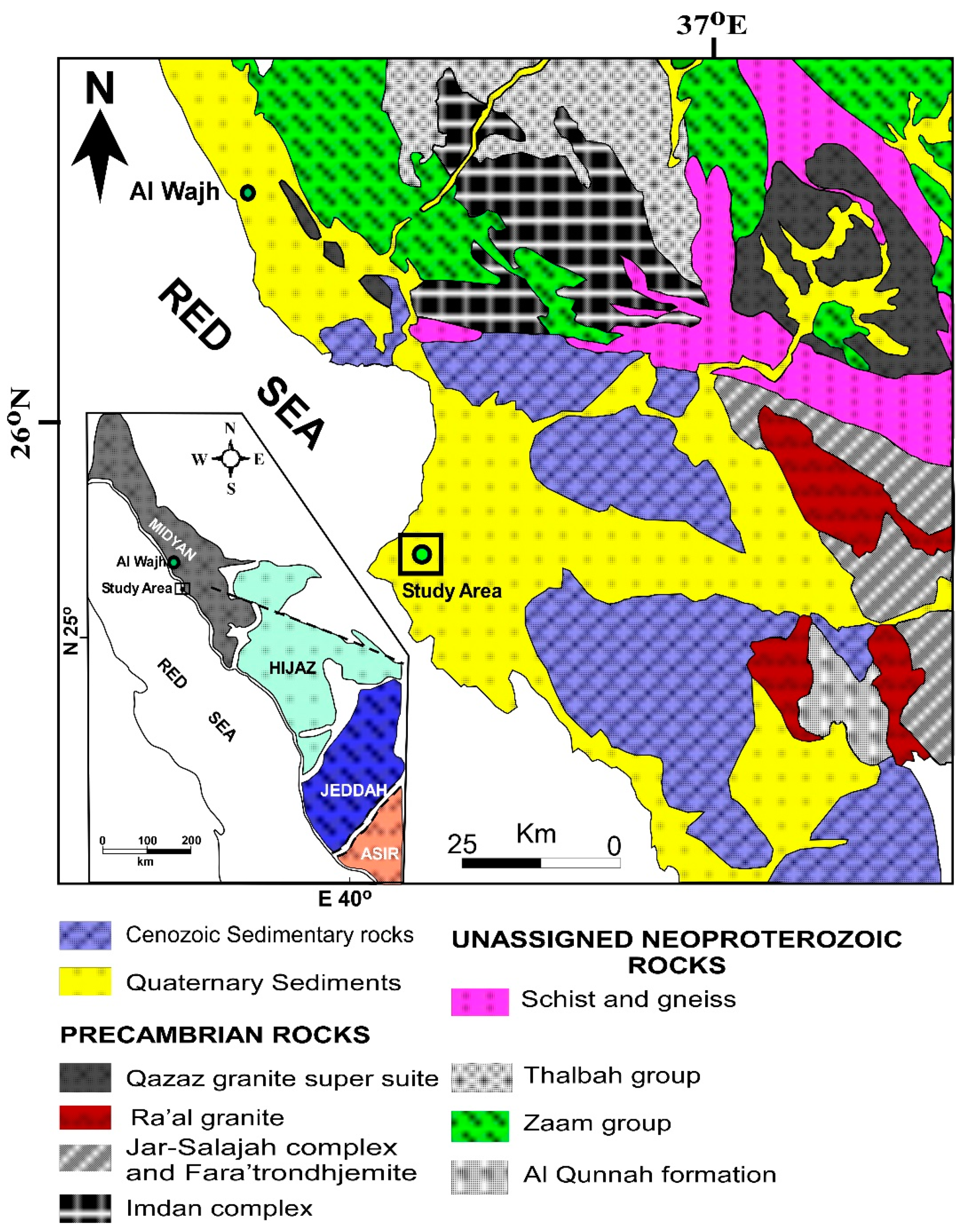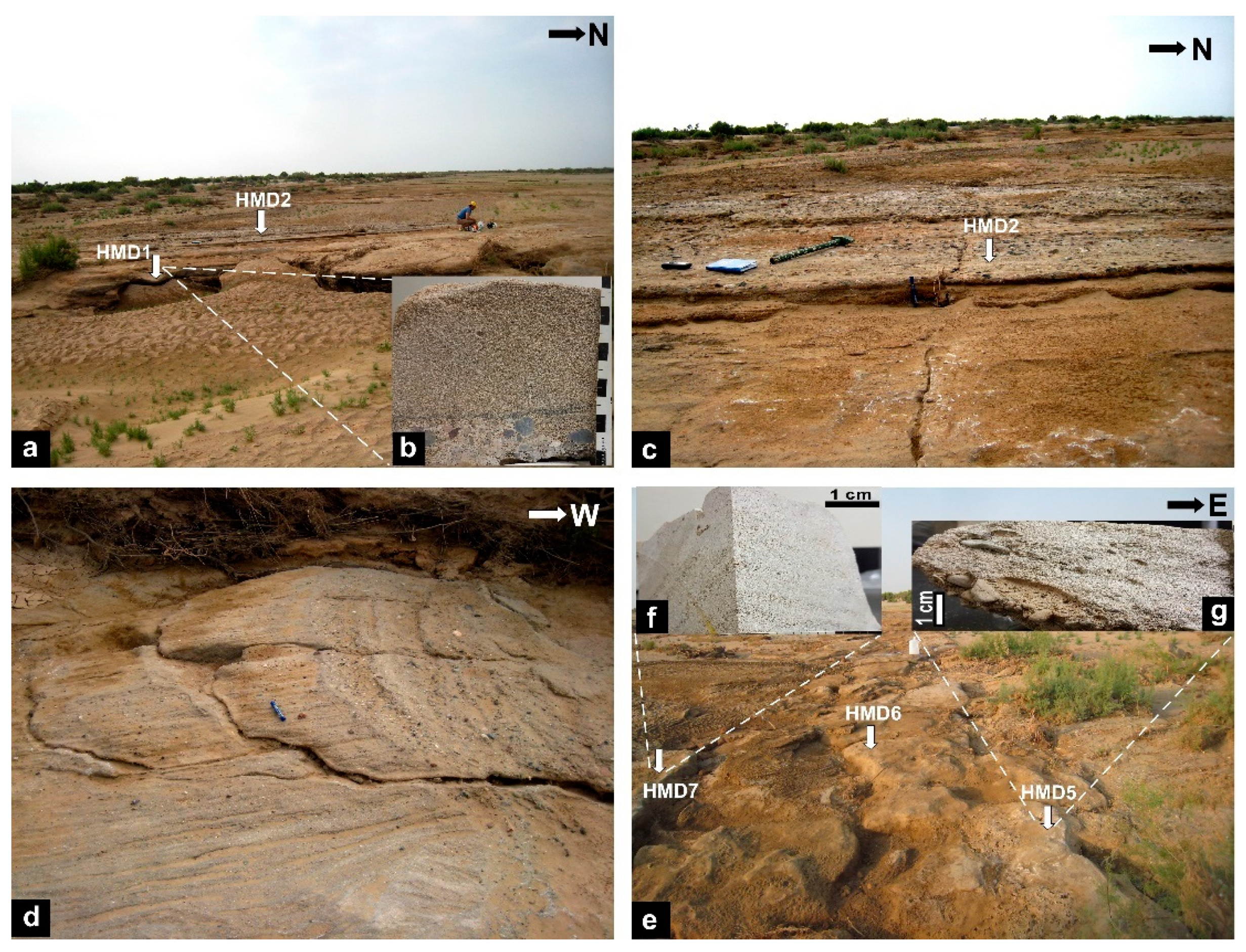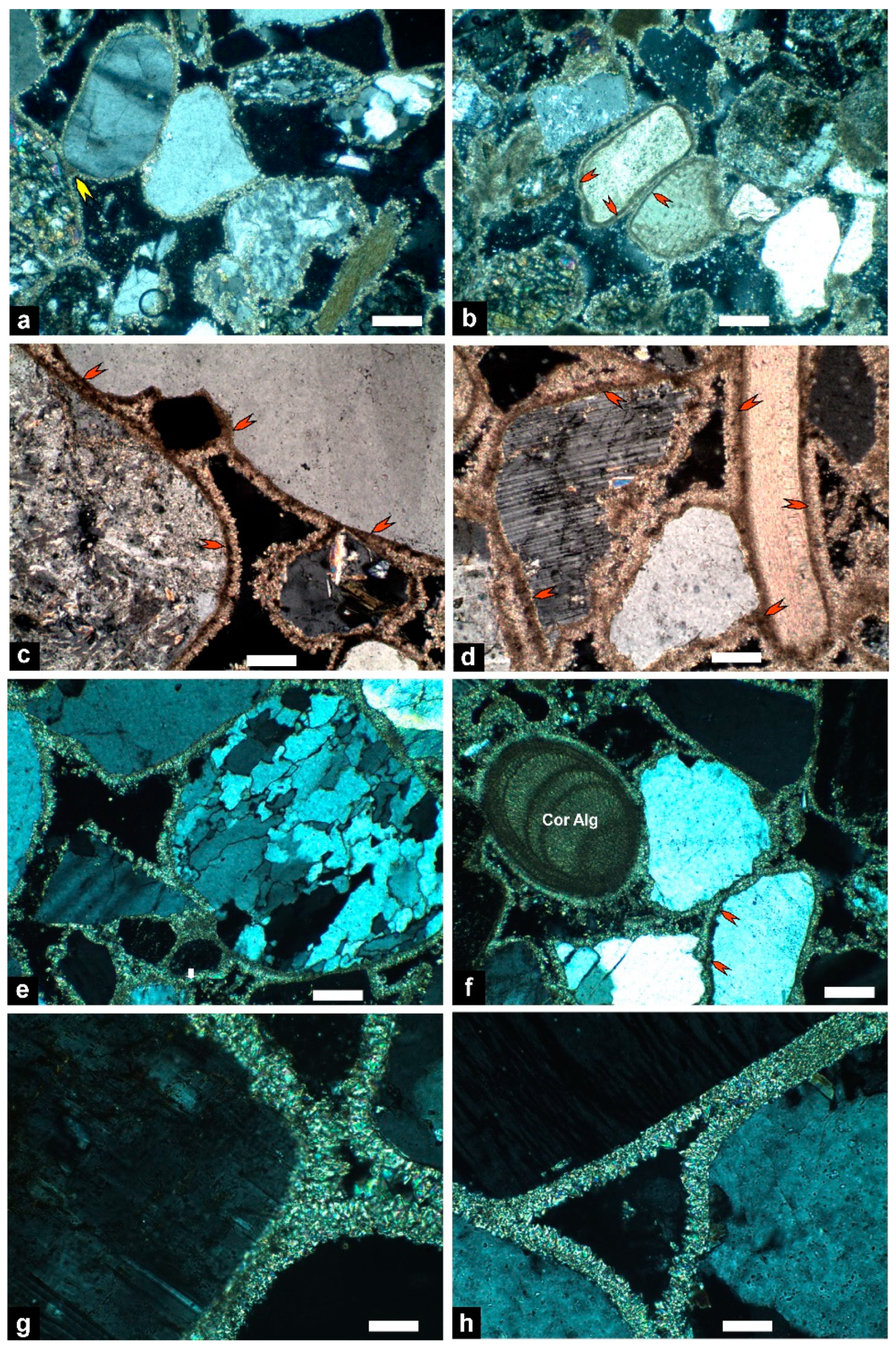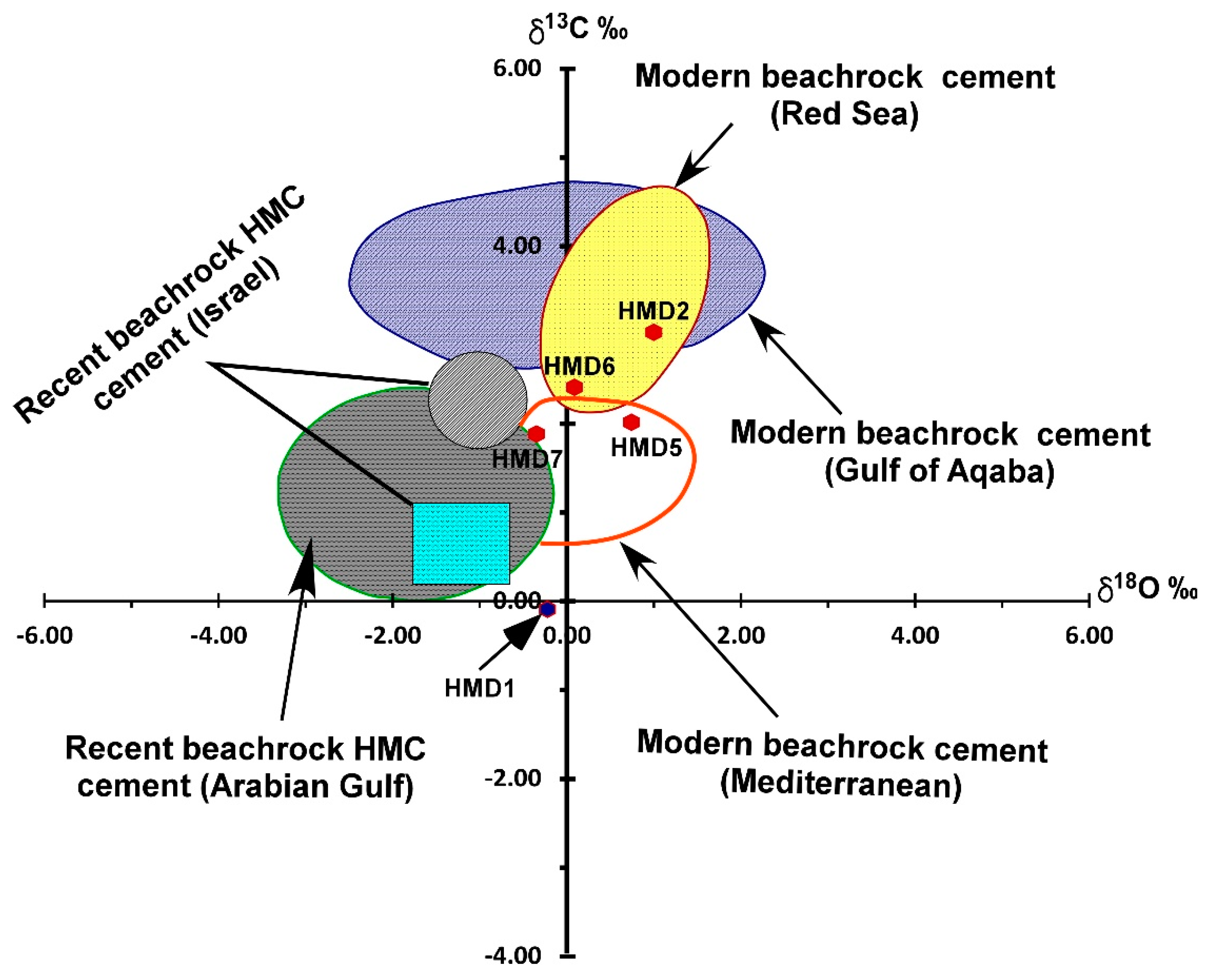Beachrock as a Paleoshoreline Indicator: Example from Wadi Al-Hamd, South Al-Wajh, Saudi Arabia
Abstract
:1. Introduction
2. Area of Study
3. Materials and Methods
4. Results
4.1. Framework Composition and Cementation
4.2. Carbon and Oxygen Stable Isotopes
5. Discussion
Cementation Patterns
6. Conclusions
- The grain size, sedimentary structures and framework compositions indicate that the sediments were derived during humid intervals mainly from a terrigenous source, with little contribution of marine derived calcareous skeletal remains. They were deposited in a high-energy beach environment.
- Deposition in the beach environment suggests that the shoreline backstepped more landward during a period of relative sea level rise. The beachrock at the mouth of Wadi Al-Hamd is therefore a paleoshoreline indicator.
- The suggested humid climate and relative sea level highstand may be correlated with the middle Holocene humid interval and sea level highstand.
- The dominant isopachous bladed and micritic Mg-calcite cement suggests that cement growth in the intertidal zone under active marine phreatic conditions. This is supported by the isotopic data and Z values that indicate that the cement generally originated from marine water. The meniscus fabric and the depletion of oxygen and carbon isotope values in the most proximal sample may suggest a slight contribution from meteoric water in the vadose environment.
Author Contributions
Funding
Institutional Review Board Statement
Informed Consent Statement
Data Availability Statement
Acknowledgments
Conflicts of Interest
References
- Vacchi, M.; Marriner, N.; Morhange, C.; Spada, G.; Fontana, A.; Rovere, A. Multiproxy assessment of Holocene relative sea-level changes in the western Mediterranean: Sea-level variability and improvements in the definition of the isostatic signal. Earth-Sci. Rev. 2016, 155, 172–197. [Google Scholar] [CrossRef] [Green Version]
- Nakada, M.; Kimura, R.; Okuno, J.; Moriwaki, K.; Miura, H.; Maemoku, H. Late Pleistocene and Holocene melting history of the Antarctic ice sheet derived from sea-level variations. Mar. Geol. 2000, 167, 85–103. [Google Scholar] [CrossRef]
- Demenocal, P.; Ortiz, J.; Guilderson, T.; Adkins, J.; Sarnthein, M.; Baker, L.; Yarusinsky, M. Abrupt onset and termination of the African Humid Period: Rapid climate responses to gradual insolation forcing. Quat. Sci. Rev. 2000, 19, 347–361. [Google Scholar] [CrossRef]
- Hein, C.J.; FitzGerald, D.M.; Milne, G.A.; Bard, K.; Fattovich, R. Evolution of a Pharaonic harbor on the Red Sea: Implications for coastal response to changes in sea level and cli-mate. Geology 2011, 39, 687–690. [Google Scholar] [CrossRef]
- Ghandour, İ.M.; Al-Washmi, H.A.; Haredy, R.A.; Al-Zubieri, A.G. Facies evolution and depositional model of an arid microtidal coast: Example from the coastal plain at the mouth of Wadi Al-Hamd, Red Sea, Saudi Arabia. Turk. J. Earth Sci. 2016, 25, 256–273. [Google Scholar] [CrossRef]
- Ghandour, I.M.; Al-Zubieri, A.G.; Basaham, A.S.; Mannaa, A.A.; Al-Dubai, T.A.; Jones, B.G. Mid-Late Holocene Paleoenvironmental and Sea Level Reconstruction on the Al Lith Red Sea Coast, Saudi Arabia. Front. Mar. Sci. 2021. [Google Scholar] [CrossRef]
- Ghandour, I.M.; Haredy, R.A. Facies analysis and sequence stratigraphy of Al-Kharrar lagoon coastal sediments, Rabigh Area, Saudi Arabia: Impact of sea-level and climate changes on coastal evolution. Arab. J. Sci. Eng. 2019, 44, 505–520. [Google Scholar] [CrossRef]
- Abu-Zied, R.H.; Bantan, R.A. Palaeoenvironment, palaeoclimate and sea-level changes in the Shuaiba Lagoon during the late Holocene (last 3.6 ka), eastern Red Sea coast, Saudi Arabia. Holocene 2015, 25, 1301–1312. [Google Scholar] [CrossRef]
- Bantan, R.A.; Abu-Zied, R.H.; Al-Dubai, T.A. Late Holocene environmental changes in a sediment core from Al-Kharrar Lagoon, eastern Red Sea Coast, Saudi Arabia. Arab. J. Sci. Eng. 2019, 44, 6557–6570. [Google Scholar] [CrossRef]
- Dickinson, W.R. Paleoshoreline record of relative Holocene sea levels on Pacific islands. Earth-Sci. Rev. 2001, 55, 191–234. [Google Scholar] [CrossRef]
- Shaked, Y.; Marco, S.; Lazar, B.; Stein, M.; Cohen, C.; Sass, E.; Agnon, A. Late Holocene shorelines at the Gulf of Aqaba: Migrating shorelines under conditions of tectonic and sea level stability. EGU Stephan Mueller Spec. Publ. Ser. 2002, 2, 105–111. [Google Scholar] [CrossRef]
- de Oliveira Caldas, L.H.; Stattegger, K.; Vital, H. Holocene sea-level history: Evidence from coastal sediments of the northern Rio Grande do Norte coast, NE Brazil. Mar. Geol. 2006, 228, 39–53. [Google Scholar] [CrossRef]
- Mauz, B.; Vacchi, M.; Green, A.; Hoffmann, G.; Cooper, A. Beachrock: A tool for re-constructing relative sea level in the far-field. Mar. Geol. 2015, 362, 1–6. [Google Scholar] [CrossRef]
- Manaa, A.A.; Jones, B.G.; McGregor, H.V.; Zhao, J.X.; Price, D.M. Dating Quaternary raised coral terraces along the Saudi Arabian Red Sea coast. Mar. Geol. 2016, 374, 59–72. [Google Scholar] [CrossRef] [Green Version]
- Kelletat, D. Beachrock as sea-level indicator? Remarks from a geomorphological point of view. J. Coast. Res. 2006, 22, 1558–1564. [Google Scholar] [CrossRef]
- Ozturk, M.Z.; Erginal, A.E.; Kiyak, N.G.; Ozturk, T. Cement fabrics and optical luminescence ages of beachrock, North Cyprus: Implications for Holocene sea-level changes. Quat. Int. 2016, 401, 132–140. [Google Scholar] [CrossRef]
- Karkani, A.; Evelpidou, N.; Vacchi, M.; Morhange, C.; Tsukamoto, S.; Frechen, M.; Maroukian, H. Tracking shoreline evolution in central Cyclades (Greece) using beachrocks. Mar. Geol. 2017, 388, 25–37. [Google Scholar] [CrossRef]
- Falkenroth, M.; Schneider, B.; Hoffmann, G. Beachrock as sea-level indicator–a case study at the coastline of Oman (Indian Ocean). Quat. Sci. Rev. 2019, 206, 81–98. [Google Scholar] [CrossRef]
- Holail, H.; Rashed, M. Stable isotopic composition of carbonate-cemented recent beachrock along the Mediterranean and the Red Sea coasts of Egypt. Mar. Geol. 1992, 106, 141–148. [Google Scholar] [CrossRef]
- Vousdoukas, M.I.; Velegrakis, A.F.; Plomaritis, T.A. Beachrock occurrence, characteris-tics, formation mechanisms and impacts. Earth-Sci. Rev. 2007, 85, 23–46. [Google Scholar] [CrossRef]
- Erginal, A.E.; Güneç, N.K.; Bozcu, M.; Ertek, A.; Güngüneş, H.; Sungur, A.; Türker, G. On the origin and age of the Arıburnu beachrock, Gelibolu Peninsula, Turkey. Turk. J. Earth Sci. 2008, 17, 803–819. [Google Scholar]
- Ghandour, I.M.; Al-Washmi, H.A.; Bantan, R.A.; Gadallah, M.M. Petrographical and petrophysical characteristics of asynchronous beachrocks along Al-Shoaiba Coast, Red Sea, Saudi Arabia. Arab. J. Geosci. 2014, 7, 355–365. [Google Scholar] [CrossRef]
- Milliman, J.D. Recent Sedimentary Carbonates: Part 1 Marine Carbonates; Springer: New York, NY, USA, 1974; p. 375. [Google Scholar]
- Hanor, J.S. Precipitation of beachrock cements; mixing of marine and meteoric waters vs. CO2-degassing. J. Sediment. Res. 1978, 48, 489–501. [Google Scholar]
- Neumeier, U. Experimental modelling of beachrock cementation under microbial influence. Sediment. Geol. 1999, 126, 35–46. [Google Scholar] [CrossRef]
- El-Shater, A.; Abu Ouf, M.A. Beachrock in South Jeddah, The Red Sea Coast of Saudi Arabia. J King Abdulaziz Univ. Mar. Sci. 1995, 6, 53–65. [Google Scholar] [CrossRef]
- Al-Ramadan, K. Diagenesis of Holocene beachrocks: A comparative study between the Arabian Gulf and the Gulf of Aqaba, Saudi Arabia. Arab. J. Geosci. 2014, 7, 4933–4942. [Google Scholar] [CrossRef]
- Koeshidayatullah, A.; Al-Ramadan, K. Unraveling cementation environment and patterns of Holocene beachrocks in the Arabian Gulf and the Gulf of Aqaba: Stable isotope ap-proach. Geol. Q. 2014, 58, 207–216. [Google Scholar] [CrossRef] [Green Version]
- Haredy, R.A.; Ghandour, I.M.; Erginal, A.E.; Bozcu, M. Beachrock Cementation Patterns Along the Gulf of Aqaba Coast, Saudi Arabia. Arab. J. Sci. Eng. 2019, 44, 479–487. [Google Scholar] [CrossRef]
- Strasser, A.; Strohmenger, C.; Davaud, E.; Bach, A. Sequential evolution and diagenesis of Pleistocene coral reefs (South Sinai, Egypt). Sediment. Geol. 1992, 78, 59–79. [Google Scholar] [CrossRef]
- Strasser, A.; Strohmenger, C. Early diagenesis in Pleistocene coral reefs, southern Sinai, Egypt: Response to tectonics, sea-level and climate. Sedimentology 1997, 44, 537–558. [Google Scholar] [CrossRef]
- Holail, H.M.; Shaaban, M.N.; Mansour, A.S. Cementation of Holocene beachrock in the Aqaba and the Arabian Gulfs: Comparative study. Carbonates Evaporites 2004, 19, 142–150. [Google Scholar] [CrossRef]
- Morcos, S.A. Physical and chemical oceanography of the Red Sea. Oceanogr. Mar. Biol. Annu. Rev. 1970, 8, 73–202. [Google Scholar]
- Ghandour, I.M.; Al-Washmi, H.A.; Haredy, R.A. Gravel-sized mud clasts on an arid microtidal sandy beach: Example from the northeastern Red Sea, South Al-Wajh, Saudi Arabia. J. Coast. Res. 2013, 29, 110–117. [Google Scholar] [CrossRef]
- Bantan, R.A.; Ghandour, I.M.; Al-Zubieri, A.G. Mineralogical and geochemical composition of the subsurface sediments at the mouth of Wadi Al-Hamd, Red Sea coast, Saudi Arabia: Implication for provenance and climate. Environ. Earth Sci. 2020, 79, 1–20. [Google Scholar] [CrossRef]
- Moufti, A.M. Mineralogy and mineral chemistry of auriferous stream sediments from Al Wajh area, NW Saudi Arabia. Arab. J. Geosci. 2009, 2, 1–17. [Google Scholar] [CrossRef]
- Davies, F.B. Explanatory Notes on the Geologic Map of Al Wajh Quadrangle, Sheet 26 B; Ministry of Petroleum and Mineral Resources, Deputy Ministry for Mineral Resources: Jeddah, Saudi Arabia, 1985; p. 27. [Google Scholar]
- Sherrod, L.A.; Dunn, G.; Peterson, G.A.; Kolberg, R.L. Inorganic carbon analysis by modified pressure-calcimeter method. Soil Sci. Soc. Am. J. 2002, 66, 299–305. [Google Scholar] [CrossRef]
- Allan, J.R.; Matthews, R.K. Isotope signatures associated with early meteoric diagenesis. Sedimentology 1982, 29, 797–817. [Google Scholar] [CrossRef]
- Spurgeon, D.; Davis, R.A., Jr.; Shinnu, E.A. Formation of Beach Rock at Siesta Key, Florida and its influence on barrier island development. Mar. Geol. 2003, 200, 19–29. [Google Scholar] [CrossRef]
- Armstrong-Altrin, J.S.; Lee, Y.I.; Verma, S.P.; Worden, R.H. Carbon, oxygen, and strontium isotope geochemistry of carbonate rocks of the upper Miocene Kudankulam Formation, southern India: Implications for paleoenvironment and diagenesis. Geochemistry 2009, 69, 45–60. [Google Scholar] [CrossRef]
- Magaritz, M.; Gavish, E.; Bakler, N.; Kafri, U. Carbon and oxygen isotope composition-indicators of cementation environment in Recent, Holocene and Pleistocene sediments along the coast of Israel. J. Sediment. Petrol. 1979, 49, 401–411. [Google Scholar]
- Beier, J.A. Diagenesis of Quaternary Bahamian beachrock; petrographic and isotopic evidence. J. Sediment. Res. 1985, 55, 755–761. [Google Scholar] [CrossRef]
- Keith, M.L.; Weber, J.N. Carbon and oxygen isotopic composition of selected limestones and fossils. Geochim. et Cosmochim. Acta 1964, 28, 1787–1816. [Google Scholar] [CrossRef]
- Rao, N.D.; Behairy, A.K. Intertidal conglomerate south of Yanbu-An episodic clastic deposit in the eastern Red Sea. Palaeogeogr. Palaeoclimatol. Palaeoecol. 1987, 58, 221–228. [Google Scholar]
- Ghandour, I.M. Controlling factors on the textural characteristics of the coastal sediments around Wadi Al-Hamd mouth Delta, NE Red Sea, Saudi Arabia. J. King Abdulaziz Univ. Mar. Sci. 2014, 25, 61–78. [Google Scholar] [CrossRef]
- Al-Zubieri, A.G.; Ghandour, I.M.; Haredy, R.A. Controlling factors on the grain size distribution of shallow subsurface coastal sediments at the mouth of Wadi Al-Hamd, northeastern Red Sea, Saudi Arabia. J. King Abdulaziz Univ. Mar. Sci. 2018, 27, 1–17. [Google Scholar]
- Jado, A.R.; Zötl, J.G. Quaternary period in Saudi Arabia; Springer: Wien, Austria, 1984; p. 360. [Google Scholar]
- Moustafa, Y.A.; Pätzold, J.; Loya, Y.; Wefer, G. Mid-Holocene stable isotope record of corals from the northern Red Sea. Int. J. Earth Sci. 2000, 88, 742–751. [Google Scholar] [CrossRef]
- Clifton, H.E. Progradational sequences in Miocene shoreline deposits, southeastern Caliente Range, California. J. Sediment. Res. 1981, 51, 165–184. [Google Scholar]
- Khanna, P.; Petrovic, A.; Ramdani, A.I.; Homewood, P.; Mettraux, M.; Vahrenkamp, V. Mid-Holocene to present circum-Arabian sea level database: Investigating future coastal ocean inundation risk along the Arabian plate shorelines. Quat. Sci. Rev. 2021, 261, 106959. [Google Scholar] [CrossRef]
- Al-Mikhlafi, A.S.; Hibbert, F.D.; Edwards, L.R.; Cheng, H. Holocene relative sea-level changes and coastal evolution along the coastlines of Kamaran Island and As-Salif Pen-insula, Yemen, southern Red Sea. Quat. Sci. Rev. 2021, 252, 106719. [Google Scholar] [CrossRef]
- Murray-Wallace, C.V.; Woodroffe, C.D. Quaternary Sea-Level Changes: A Global Perspective; Cambridge University Press: New York, NY, USA, 2014; p. 484. [Google Scholar]
- James, N.P.; Choquette, P.W. Limestone: The sea floor diagenetic environment. In Diagenesis; McIlreath, I., Morrow, D., Eds.; Geological Association of Canada Reprint Series: St John’s, ND, Canada, 1990; pp. 13–34. [Google Scholar]
- Vieira, M.M.; De Ros, L.F. Cementation patterns and genetic implications of Holocene beachrocks from northeastern Brazil. Sediment. Geol. 2006, 192, 207–230. [Google Scholar] [CrossRef]
- Desruelles, S.; Fouache, É.; Ciner, A.; Dalongeville, R.; Pavlopoulos, K.; Kosun, E.; Coquinot, Y.; Potdevin, J.L. Beachrocks and sea level changes since Middle Holocene: Comparison between the insular group of Mykonos–Delos–Rhenia (Cyclades, Greece) and the southern coast of Turkey. Glob. Planet. Chang. 2009, 66, 19–33. [Google Scholar] [CrossRef]
- Alexanderson, T. Mediterranean beachrock cementation: Marine precipitation of Mg-calcite. In The Mediterranean Sea: A Natural Sedimentation Laboratory; Stanley, D.J., Ed.; Dowden, Hutchinson and Ross Publishers: Stroudsburg, PA, USA, 1972; pp. 203–223. [Google Scholar]
- Strasser, A.; Davaud, E.; Jedoui, Y. Carbonate cements in Holocene beachrock: Example from Bahiret et Biban, southeastern Tunisia. Sediment. Geol. 1989, 62, 89–100. [Google Scholar] [CrossRef]
- Meyers, J.H. Marine vadose beachrock cementation by cryptocrystalline magnesian cal-cite, Maui, Hawaii. J. Sediment. Res. 1987, 57, 558–570. [Google Scholar]
- Chaves, N.S.; Sial, A.N. Mixed oceanic and freshwater depositional conditions for beachrocks of Northeast Brazil: Evidence from carbon and oxygen isotopes. Int. Geol. Rev. 1998, 40, 748–754. [Google Scholar] [CrossRef]
- Calvet, F.; Cabrera, M.C.; Carracedo, J.C.; Mangas, J.; Pérez-Torrado, F.J.; Recio, C.; Travé, A. Beachrocks from the island of La Palma (Canary Islands, Spain). Mar. Geol. 2003, 197, 75–93. [Google Scholar] [CrossRef]
- Vieira, M.M.; Sial, A.N.; De Ros, L.F.; Morad, S. Origin of Holocene beachrock cements in northeastern Brazil: Evidence from carbon and oxygen isotopes. J. South Am. Earth Sci. 2017, 79, 401–408. [Google Scholar] [CrossRef]
- Hudson, J.D. Stable isotopes of limestone lithification. J. Geol. Soc. Lond. 1977, 133, 637–660. [Google Scholar] [CrossRef]
- Coudray, J.; Montaggioni, L. The diagenetic products of marine carbonate as sea level indicators. In Sea-Level Research: A Manual for the Collection and Evaluation of Data; Plassche, O.V.D., Ed.; Geo Books: Norwich, UK, 1986; pp. 311–360. [Google Scholar]






| Sample | δ 13CVPDB‰ | δ 18OVPDB‰ | Z Values | CaCO3% |
|---|---|---|---|---|
| HMD 1 | −0.09 | −0.22 | 127 | 28 |
| HMD 2 | 3.03 | 1.00 | 134 | 29 |
| HMD 5 | 2.02 | 0.74 | 131.8 | 27 |
| HMD 6 | 2.41 | 0.08 | 132.3 | 29 |
| HMD 7 | 1.89 | −0.35 | 131 | 53 |
Publisher’s Note: MDPI stays neutral with regard to jurisdictional claims in published maps and institutional affiliations. |
© 2021 by the authors. Licensee MDPI, Basel, Switzerland. This article is an open access article distributed under the terms and conditions of the Creative Commons Attribution (CC BY) license (https://creativecommons.org/licenses/by/4.0/).
Share and Cite
Mannaa, A.A.; Haredy, R.A.; Ghandour, I.M. Beachrock as a Paleoshoreline Indicator: Example from Wadi Al-Hamd, South Al-Wajh, Saudi Arabia. J. Mar. Sci. Eng. 2021, 9, 984. https://doi.org/10.3390/jmse9090984
Mannaa AA, Haredy RA, Ghandour IM. Beachrock as a Paleoshoreline Indicator: Example from Wadi Al-Hamd, South Al-Wajh, Saudi Arabia. Journal of Marine Science and Engineering. 2021; 9(9):984. https://doi.org/10.3390/jmse9090984
Chicago/Turabian StyleMannaa, Ammar A., Rabea A. Haredy, and Ibrahim M. Ghandour. 2021. "Beachrock as a Paleoshoreline Indicator: Example from Wadi Al-Hamd, South Al-Wajh, Saudi Arabia" Journal of Marine Science and Engineering 9, no. 9: 984. https://doi.org/10.3390/jmse9090984
APA StyleMannaa, A. A., Haredy, R. A., & Ghandour, I. M. (2021). Beachrock as a Paleoshoreline Indicator: Example from Wadi Al-Hamd, South Al-Wajh, Saudi Arabia. Journal of Marine Science and Engineering, 9(9), 984. https://doi.org/10.3390/jmse9090984






